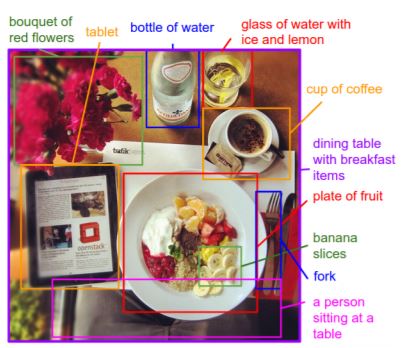Generating Image Descriptions
This Page is Under Construction.
Introduction and Motivation
People often say that a picture is worth a thousand words, but with the current tools available, NLP and image recognition algorithms are unable to extract nearly that much meaningful text from images. Contrarily, when a human glances at an image, they can easily identify numerous details and relationships within a detailed visual scene. Despite numerous advancements in image classification, object detection, and natural language processing, this particular task has proven challenging for existing visual recognition models. The majority of similar visual recognition models focus on labeling objects [CITATIONS], or generating image descriptions based on limited vocabularies and fixed sentence models [CITATIONS]. The authors of this paper believed that the assumptions of these types of models were too restrictive, leading to an inability to generate rich descriptions that the human mind is capable of.
In this paper, the restriction of hard-coded word templates, and sentence structures are removed. Using this assumption-free ideal, the Kapersky and Li create a model that can generate richer descriptions drawn from a wider vocabulary. Due to the lack of directly relevant training data for this task, the authors leveraged the large quantity of images with detailed captions available online. Although these images contained no explicit information about image region labels or relationships between regions, they could treat individual captions as weak labels in which contiguous segments of words correspond to some particular, but unknown location in the image. By inferring the location of alignment between the corpus and image, a generative model is created that can generate detailed descriptions as seen in Figure 1.
In particular, this paper introduces a neural network that infers latent text relationships with corresponding image region relationships. This is achieved through an optimization problem which associates probabilities related to a multimodal image embedding space to a carefully constructed objective function. Validation of this approach is conducted on image-sentence retrieval tasks.
Furthermore, a multimodal Recurrent Neural Network (RNN) structure is used to take an input image, and generate text descriptions along with their corresponding regions. Simulations show that the generated sentences outperform rigid, retrieval based models.
Relevant Concepts
Literature Review
Before analyzing Kapersky and Li's visual recognition model in more depth, we first discuss the shortcomings of similar models.
The Model
Experimental Results
Conclusions
Throughout the entire paper, we have reached the following conclusions:
1.Generates natural language descriptions of image regions based on weak labels.
Q: What labels exactly?
A: Dataset with images and sentences.
2. This model has few hardcoded assumptions. Novel ranking through a common, multi-modal embedding.
We have taken several generative steps underlying here:
Align visual and language data:
---Detect image using RCNN, with CNN pre-trained.
---Compute the sentenced describing the image in the same dimensional embedding layers, using BRNN.
---MRNN for generating descriptions:
Main challenges —— variable size not fixed Solution: based on RNN and time series, define the next series based on current variables that we have.
Experiments:
---Image-sentence alignment ranking: High among all other methods, with a top 5 median.
---Full-frame evaluation-Image: slightly outperform many of the existing models.
---Region evaluation: Though still significant lower than human opinion, but surpassed most of the existing models.
Steps to take afterwards
Limited input properties (e.g. one input array of pixels, images need to have a fixed resolution) ***very big issue as currently a lot of images are varied in the size and resolution.***
The RNN receives the image information only through additive bias interactions, which are known to be less expressive. That being said, the interaction the model chose is case sensitive, which is hard to achieve in real life.
In this model, they divided the image-sentence data set into two parts, descriptive sentences and visual images. Is there any possibility to skip the division and solve the thing using one single model?
